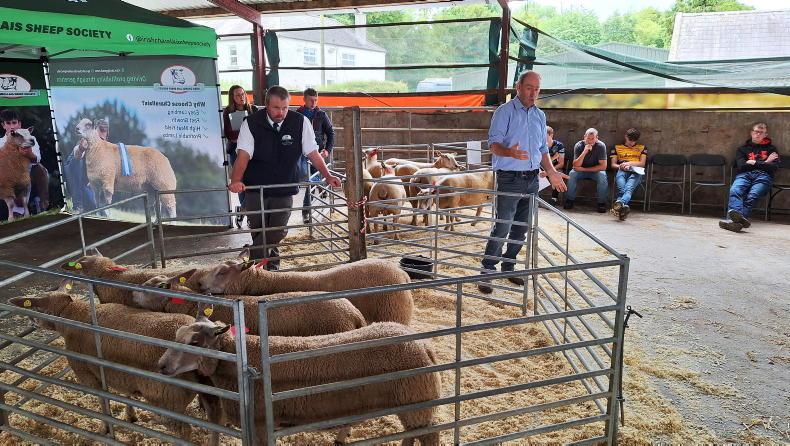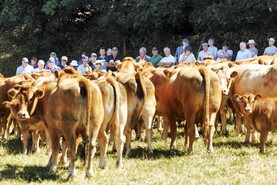Many breeders invest a lot of thought into selecting rams, often overlooking the vital role that females play. This was the focus of much discussion at a recent Irish Charollais Sheep society young and new breeders event, held on Tullamore Farm.
The day focused solely on females, including a stock-judging element of replacement ewe lambs and ewes to demonstrate the important points to hone in on. Speakers at the event were Jim Jeffrey, Bawnard flock, Pat Farrell, Nunscross flock and James Walsh Shanavagoon flock. While the discussions related to Charollais sheep, there were tips and advice applicable to all breeders.
Don’t let wool hide faults
Jim Jeffery told breeders in attendance that wool can hide a lot of faults in sheep and particularly where sheep are trimmed to exaggerate certain characteristics. He highlighted that Charollais pedigree sheep must be sold untrimmed in society sales and that this gives a better indication as to the natural shape and conformation.
Where sheep are trimmed, then it is worth getting a gauge of the true length of wool with your fingers, so that this can aid in distinguishing areas which may be trimmed. Each breed has certain characteristics which they major on and this should be taken in to account. For the Charollais breed, Jim explains that it has always promoted its easy-lambing characteristics and this should be a significant consideration.
He said that sheep must have a good level topline, which is wider at the back and narrower at the shoulders, or in a wedge-like shape.
Excessive width at the shoulders can add to lambing difficulty and a balance must be achieved between selecting sheep with good shape, but not excessive width at the shoulders. The loin should be as long as possible, with good depth of quarter.

In centre, James Walsh and Pat Farrell speaking at the Irish Charollais Sheep Society young and new breeders' event.
With regard to the head, some breeds put a lot of emphasis on the head, when it is the first part of the animal to be cast aside when slaughtering. For Charollais sheep, the aim is a pink/grey facial colour. The head is typically free from wool, but there are some breed lines with a greater cover of wool.
In terms of feet, Jim said the optimum in his opinion is animals that stand with four good legs and which are not sitting back on their pasterns. In this regard, he said a shorter pastern is generally better, as it is less likely to lead to faults and feet issues.
Female’s job is to raise a good lamb
Pat Farrell stated that the main role of a ewe is to deliver a live lamb and do a good job rearing it. He said that in terms of physical appearance, ewes should be maternal looking: “She has to look like a female and have a female looking head – and likewise a male head on a male.”
Ewes that are terminal-looking in appearance and extreme in type, regularly do not make high-performing ewes.
In Pat’s opinion, the mouth is an area that is often not given the focus it deserves. Teeth should align with the dental pad correctly, with no signs of issues in back teeth.
He adds that issues such as over- or under-shot mouths can take a long time to rectify if bred into a flock.
In terms of the length of the loin this is where the most value is in the carcase. He said that he uses a simple measure when comparing sheep, of the distance of an open hand and the distance from the incisor finger to the thumb to compare length. This, Pat says, is a more valuable assessment rather than looking at the overall size of the sheep.
For genetics, investigating the sire and ewe genetics can shed some light as to the breeding potential. Pat says that in his opinion ewe milk yield should have a greater role in the index calculation given the vital role it plays in driving lamb performance.
He concludes by adding that breeder preference also has to feature, as breeders need to get enjoyment from the practice of selecting sheep, keeping in mind what characteristics commercial farmers desire, as ultimately sheep need to perform in a commercial environment.
Many breeders invest a lot of thought into selecting rams, often overlooking the vital role that females play. This was the focus of much discussion at a recent Irish Charollais Sheep society young and new breeders event, held on Tullamore Farm.
The day focused solely on females, including a stock-judging element of replacement ewe lambs and ewes to demonstrate the important points to hone in on. Speakers at the event were Jim Jeffrey, Bawnard flock, Pat Farrell, Nunscross flock and James Walsh Shanavagoon flock. While the discussions related to Charollais sheep, there were tips and advice applicable to all breeders.
Don’t let wool hide faults
Jim Jeffery told breeders in attendance that wool can hide a lot of faults in sheep and particularly where sheep are trimmed to exaggerate certain characteristics. He highlighted that Charollais pedigree sheep must be sold untrimmed in society sales and that this gives a better indication as to the natural shape and conformation.
Where sheep are trimmed, then it is worth getting a gauge of the true length of wool with your fingers, so that this can aid in distinguishing areas which may be trimmed. Each breed has certain characteristics which they major on and this should be taken in to account. For the Charollais breed, Jim explains that it has always promoted its easy-lambing characteristics and this should be a significant consideration.
He said that sheep must have a good level topline, which is wider at the back and narrower at the shoulders, or in a wedge-like shape.
Excessive width at the shoulders can add to lambing difficulty and a balance must be achieved between selecting sheep with good shape, but not excessive width at the shoulders. The loin should be as long as possible, with good depth of quarter.

In centre, James Walsh and Pat Farrell speaking at the Irish Charollais Sheep Society young and new breeders' event.
With regard to the head, some breeds put a lot of emphasis on the head, when it is the first part of the animal to be cast aside when slaughtering. For Charollais sheep, the aim is a pink/grey facial colour. The head is typically free from wool, but there are some breed lines with a greater cover of wool.
In terms of feet, Jim said the optimum in his opinion is animals that stand with four good legs and which are not sitting back on their pasterns. In this regard, he said a shorter pastern is generally better, as it is less likely to lead to faults and feet issues.
Female’s job is to raise a good lamb
Pat Farrell stated that the main role of a ewe is to deliver a live lamb and do a good job rearing it. He said that in terms of physical appearance, ewes should be maternal looking: “She has to look like a female and have a female looking head – and likewise a male head on a male.”
Ewes that are terminal-looking in appearance and extreme in type, regularly do not make high-performing ewes.
In Pat’s opinion, the mouth is an area that is often not given the focus it deserves. Teeth should align with the dental pad correctly, with no signs of issues in back teeth.
He adds that issues such as over- or under-shot mouths can take a long time to rectify if bred into a flock.
In terms of the length of the loin this is where the most value is in the carcase. He said that he uses a simple measure when comparing sheep, of the distance of an open hand and the distance from the incisor finger to the thumb to compare length. This, Pat says, is a more valuable assessment rather than looking at the overall size of the sheep.
For genetics, investigating the sire and ewe genetics can shed some light as to the breeding potential. Pat says that in his opinion ewe milk yield should have a greater role in the index calculation given the vital role it plays in driving lamb performance.
He concludes by adding that breeder preference also has to feature, as breeders need to get enjoyment from the practice of selecting sheep, keeping in mind what characteristics commercial farmers desire, as ultimately sheep need to perform in a commercial environment.







 This is a subscriber-only article
This is a subscriber-only article










SHARING OPTIONS: